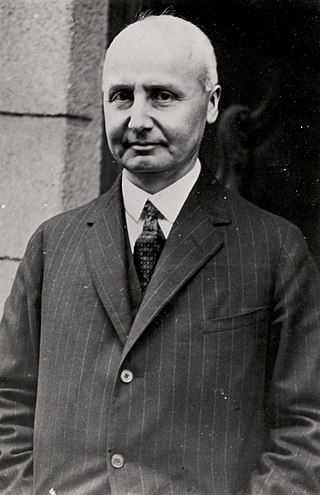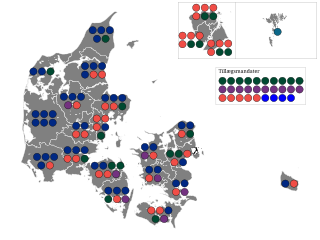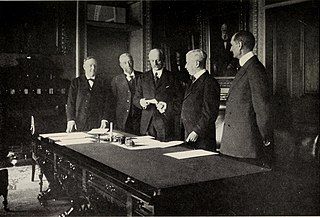
Erik Julius Christian Scavenius was the Danish foreign minister from 1909 to 1910, 1913 to 1920 and 1940 to 1943, and prime minister from 1942 to 1943, during the occupation of Denmark until the Danish elected government ceased to function. He was the foreign minister during some of the most important periods of Denmark's modern history, including the First World War, the plebiscites over the return of northern Schleswig to Denmark, and the German occupation. Scavenius was a member of the Landsting from 1918 to 1920 and from 1925 to 1927 representing the Social Liberal Party. He was chairman of its party organization from 1922 to 1924.

Rigsdagen was the name of the national legislature of Denmark from 1849 to 1953.

The Constitutional Act of the Realm of Denmark, also known as the Constitutional Act of the Kingdom of Denmark, or simply the Constitution, is the constitution of the Kingdom of Denmark, applying equally in the Realm of Denmark: Denmark proper, Greenland and the Faroe Islands. The first democratic constitution was adopted in 1849, replacing the 1665 absolutist constitution. The current constitution is from 1953. It is one of the oldest constitutions in the world. The Constitutional Act has been changed a few times. The wording is general enough to still apply today.

Landstinget was the upper house of the Rigsdag, from 1849 until 1953, when the bicameral system was abolished in favour of unicameralism. Landstinget had powers equal to the Folketing, which made the two houses of parliament hard to distinguish.

Folketing elections were held in Denmark on 6 May 1915. In order to make amendments to the constitution, the government called for the dissolution of both the Folketing and the Landsting to allow a new Rigsdag to make the revisions. However, as this was during World War I, no campaigning took place, and 105 of the 115 were uncontested.

Folketing elections were held in Denmark on 26 April 1920, except in the Faroe Islands, where they were held on 20 May. The election campaign was the most aggressive and bitter in Denmark in the 20th century. Voter turnout was 80.6% in Denmark proper and 58.8% in the Faroe Islands.
Landsting elections were held in Denmark on 11 May 1918, with the exceptions that the seats elected by the resigning parliament were elected on 20 March 1918, the Faroese member was elected on 13 May, and the electors that elected the candidates standing in the constituencies were elected on 30 April.
Landsting elections were held in Denmark on 10 August 1920, with the exceptions that the seats elected by the resigning parliament were elected on 26 June, the Faroese member was elected on 23 August, and the electors that elected the candidates standing in the constituencies were elected on 30 July.
Landsting elections were held in Denmark on 1 October 1920, with the exceptions that the seats elected by the resigning parliament were elected on 10 September, except for the representative of South Jutland County who was elected on October 7, the Faroese member was elected on 3 February 1921, and the electors that elected the candidates standing in the constituencies were elected on 24 September 1920.
Landsting elections were held in Denmark on 14 April 1939, with the exception that the electors that elected the candidates standing in the constituencies were elected on 3 April.
A constitutional referendum was held in Denmark on 23 May 1939. Voters were asked whether they approved of a new constitution. Although it was approved by 91.9% of those who voted, a turnout of only 48.9% meant that the percentage of eligible voters approving it was only 44.46%, below the 45% required by the existing constitution of 1915.
Landsting elections were held in Denmark on 23 September 1924, with the exception that the electors were elected on 18 September.
Landsting elections were held in Denmark on 21 September 1928, with the exceptions that the electors were elected on 14 September, that the candidates elected by the resigning parliament were elected on 15 August, and that the Faroese candidate was elected by the Løgting on 23 August.
Landsting elections were held in Denmark on 13 September 1932, with the exception that the electors were elected on 5 September.
Landsting elections were held in Denmark on 22 September 1936, with the exceptions that the electors were elected on 15 September and that the candidates elected by the resigning parliament were elected on 14 August.
The Society of the Friends of Peasants was a liberal Danish political society founded on 5 May 1846 by members of the provincial consultative assemblies Johan Christian Drewsen and Balthazar Christensen, with the intent to promote the liberation of the peasantry and equality among the different classes of society. Among its most politically influential members were Anton Frederik Tscherning, Jens Andersen Hansen and Carl Christian Alberti.
Landsting elections were held in Denmark on 6 April 1943, with the exception that the electors were elected on 23 March. Along with the corresponding Folketing election, it was the first election during the German occupation, and although many people feared how the Germans might react to the election, the event took place peacefully.

Andreas Frederik Krieger was a Danish politician, government minister, professor of law and supreme court judge. He was a member of the National Constitutional Assembly from 1848 to 1849, a member of the Folketing from 1849 to 1852 representing the National Liberal Party and a member of the Landsting from 1863 to 1890 representing first the National Liberal Party and later the conservative party Højre.

Hans Christian Steffensen was a Danish politician, jurist and speaker of the Landsting, a chamber of the parliament.

The Treaty of the Danish West Indies, officially the Convention between the United States and Denmark for cession of the Danish West Indies, was a 1916 treaty transferring sovereignty of the Virgin Islands in the Danish West Indies from Denmark to the United States in exchange for a sum of US$25,000,000 in gold. It is one of the most recent permanent expansions of United States territory.








